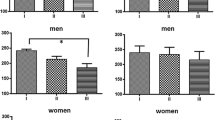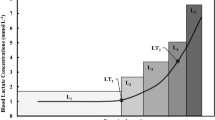Abstract
We examined the contribution of alterations in central ventilatory control, static and dynamic respiratory mechanics and their interaction to exertional breathlessness in healthy human pregnancy. Detailed ventilatory, respiratory mechanical/muscular and perceptual responses to incremental cycle exercise were compared in the third trimester (TM3) and again ∼5 months post-partum (PP) in women with (B, n = 12) and without (NB, n = 15) clinically significant activity-related breathlessness (measured by the baseline dyspnea index). In contrast to NB, breathlessness intensity ratings were significantly higher at any given work rate during exercise in TM3 versus PP within B. This difference could not be explained by differences in central ventilatory control or respiratory mechanical/muscular factors. When compared with NB, the B group had an exaggerated ventilatory response to exercise in PP and TM3, and appeared to lack central desensitization to the perceptual effects of maternal hyperventilation that was manifest within the NB group. In conclusion, gestational breathlessness could not be explained by alterations in central ventilatory control or respiratory mechanical/muscular factors, but reflected the normal awareness of increased ventilation.




Similar content being viewed by others
References
American Thoracic Society/European Respiratory Society (2002) ATS/ERS statement on respiratory muscle testing. Am J Respir Crit Care Med 166:518–624. doi:10.1164/rccm.166.4.518
Beaver WL, Wasserman K, Whipp BJ (1986) A new method for detecting anaerobic threshold by gas exchange. J Appl Physiol 60:2020–2027
Black LF, Hyatt RE (1969) Maximal respiratory pressure: normal values and relationship to age and sex. Am Rev Respir Dis 99:696–702
Borg GAV (1982) Psychophysical basis of perceived exertion. Med Sci Sports Exerc 14:377–381
Briscoe WA, Dubois AG (1959) The relationship between airway resistance, airway conductance, and lung volumes in subjects of different age and body size. J Clin Invest 37:1270–1285
Burrows B, Kasik JE, Niden AH, Barclay WR (1961) Clinical usefulness of the single-breath diffusing capacity test. Am Rev Respir Dis 84:789–806
Crapo RO, Morris AH, Clayton PD, Nixon CR (1982) Lung volumes in healthy non-smoking adults. Bull Eur Physiopathol Respir 18:419–425
Cunningham DJC (1987) Review lecture: studies on arterial chemoreceptors in man. J Physiol 384:1–26
Field SK, Bell SG, Cenaiko DF, Whitelaw WA (1991) Relationship between inspiratory effort and breathlessness in pregnancy. J Appl Physiol 71:1897–1902
Garcia-Rio F, Pino JM, Gomez L, Alvarez-Sala R, Villasante C, Villamor J (1996) Regulation of breathing and perception of dyspnea in healthy pregnant women. Chest 110:446–453. doi:10.1378/chest.110.2.446
Hamilton AL, Killian KJ, Summers E, Jones NL (1995) Muscle strength, symptom intensity, and exercise capacity in patients with cardiorespiratory disorders. Am J Respir Crit Care Med 152:2021–2031
Jennings AL, Davies AN, Higgins JPT, Gibbs JSR, Broadley KE (2002) A systematic review of the use of opioids in the management of dyspnoea. Thorax 57:939–944. doi:10.1136/thorax.57.11.939
Jensen D, Wolfe LA, O’Donnell DE, Davies GAL (2005) Chemoreflex control of breathing during wakefulness in healthy men and women. J Appl Physiol 98:822–828. doi:10.1152/japplphysiol.01208.2003
Jensen D, Webb KA, O’Donnell DE (2007) Chemical and mechanical adaptations of the respiratory system at rest and during exercise in human pregnancy. Appl Physiol Nutr Metab 32:1239–1250. doi:10.1139/H07-120
Jensen D, Amjadi K, Harris-McAllister V, Webb KA, O’Donnell DE (2008a) Mechanisms of dyspnoea relief and improved exercise endurance after furosemide inhalation in COPD. Thorax 63:606–613. doi:10.1136/thx.2007.085993
Jensen D, Duffin J, Lam YM, Webb KA, Simpson JA, Davies GAL, Wolfe LA, O’Donnell DE (2008b) Physiological mechanisms of hyperventilation during human pregnancy. Respir Physiol Neurobiol 161:76–86. doi:10.1016/j.resp.2008.01.001
Jensen D, Webb KA, Davies GAL, O’Donnell DE (2008c) Mechanical ventilatory constraints during incremental cycle exercise in human pregnancy: implications for respiratory sensation. J Physiol 86:4735–4750. doi:10.1113/jphysiol.2008.158154
Jensen D, Ofir D, O’Donnell DE (2009) Effects of pregnancy, obesity and aging on the intensity of perceived breathlessness during exercise in healthy humans. Respir Physiol Neurobiol. doi:10.1016/j.resp.2009.01.011
Jones NL (1997) Clinical exercise testing, 2nd edn. WB Saunders Co, Philadelphia, pp 124–149
Knudson RJ, Lebowitz MD, Holberg CJ, Burrows B (1983) Changes in normal maximal expiratory flow-volume curves with growth and aging. Am Rev Respir Dis 127:725–734
Lehman V (1975) Dyspnea in pregnancy. J Perinat Med 3:154–160
MacIntyre N, Crapo RO, Viegi G et al (2005) Standardisation of the single-breath determination of carbon monoxide uptake in the lung. Eur Respir J 26:720–735. doi:10.1183/09031936.05.00034905
Mahler DA, Weinberg DH, Wells CK, Feinstein AR (1984) The measurement of dyspnea: contents, interobserver agreement, and physiologic correlates of two new clinical indexes. Chest 85:751–758. doi:10.1378/chest.85.6.751
McMurray RG, Berry MJ, Katz V (1990) The beta-endorphin response of pregnant women during aerobic exercise in the water. Med Sci Sports Exerc 22:298–303. doi:10.1249/00005768-199006000-00005
Miller MR, Crapo R, Hankinson J et al (2005a) General considerations for lung function testing. Eur Respir J 26:153–161. doi:10.1183/09031936.05.00034505
Miller MR, Hankinson J, Brusasco V et al (2005b) Standardisation of spirometry. Eur Respir J 26:319–338. doi:10.1183/09031936.05.00034805
Milne JA, Howie AD, Pack AI (1978) Dyspnea during normal pregnancy. Br J Obstet Gynaecol 85:260–263
Moore LG, McCullough RE, Weil JV (1987) Increased HVR in pregnancy: relationship to hormonal and metabolic changes. J Appl Physiol 62:158–163
Morris JF, Koski A, Temple WP, Claremont A, Thomas DR (1988) Fifteen-year interval spirometric evaluation of the Oregon predictive equations. Chest 92:123–127. doi:10.1378/chest.93.1.123
Nettlefold LA, Jensen D, Janssen I, Wolfe LA (2007) Ventilatory control and acid-base regulation across the menstrual cycle in oral contraceptive users. Respir Physiol Neurobiol 158:51–58. doi:10.1016/j.resp.2007.04.005
O’Donnell DE, Bertley JC, Chau LL, Webb KA (1997) Qualitative aspects of exertional breathlessness in chronic airflow limitation: pathophysiologic mechanisms. Am J Respir Crit Care Med 155:109–115
O’Donnell DE, Lam M, Webb KA (1998) Measurement of symptoms, lung hyperinflation and endurance during exercise in chronic obstructive pulmonary disease. Am J Respir Crit Care Med 158:1557–1565
O’Donnell DE, Hong HH, Webb KA (2000) Respiratory sensation during chest wall restriction and dead space loading in exercising men. J Appl Physiol 88:1859–1869
O’Donnell DE, Hamilton AL, Webb KA (2006) Sensory-mechanical relationships during high-intensity, constant-work-rate exercise in COPD. J Appl Physiol 101:1025–1035. doi:10.1152/japplphysiol.01470.2005
Preston ME, Jensen D, Janssen I, Fisher JT (2008) Effect of menopause on the chemical control of breathing and its relationship with acid-base status. Am J Physiol Regul Integ Comp Physiol. doi:10/1152/ajpregu.90865.2008
Sgherza AL, Axen K, Fain R, Hoffman RS, Dunbar CC, Haas F (2002) Effect of naloxone on perceived exertion and exercise capacity during maximal cycle ergometry. J Appl Physiol 93:2023–2028
Slatkovska L, Jensen D, Davies GAL, Wolfe LA (2006) Phasic menstrual cycle effects on the control of breathing in healthy women. Respir Physiol Neurobiol 154:379–388. doi:10.1016/j.resp.2006.01.011
Stoller JK, Ferranti R, Feinstein AR (1986) Further specification and evaluation of a new clinical index for dyspnea. Am Rev Respir Dis 135:1129–1134
Stubbing DG, Pengelly LD, Morse JLC, Jones NL (1980) Pulmonary mechanics during exercise in normal males. J Appl Physiol 49:506–510
Tobin MJ (1998) Monitoring respiratory mechanics in spontaneously breathing patients. In: Tobin M (ed) Principles and practice of intensive care monitoring. McGraw-Hill Inc, New York, pp 617–654
Wanger J, Clausen JL, Coates A et al (2005) Standardisation of the measurement of lung volumes. Eur Respir J 26:511–522. doi:10.1183/09031936.05.00035005
Wasserman K, Hansen JE, Sue DY, Stringer WW, Whipp BJ (2005) Principles of exercise testing and interpretation, 4th edn. Lippincott Williams & Wilkins, Baltimore, pp 86–90
Yan S, Kaminski D, Sliwinski P (1997) Reliability of inspiratory capacity for estimating end expiratory lung volume changes during exercise in patients with chronic obstructive pulmonary disease. Am J Respir Crit Care Med 156:55–59
Acknowledgments
The authors would like to acknowledge Dr. Larry A. Wolfe (25 May 1950–29 July 2005) for his contribution to the original study design and grant application. This research was funded by the Ontario Thoracic Society (Grant-in Aid); Ontario Thoracic Society (Block Term Grant); and William M. Spear Endowment Fund for Respiratory Research at Queen’s University. D. Jensen was supported by an Ontario Graduate Scholarship and the John Alexander Stewart Fellowship (Department of Medicine, Queen’s University and Kingston General Hospital).
Conflict of interest statement
None.
Author information
Authors and Affiliations
Corresponding author
Rights and permissions
About this article
Cite this article
Jensen, D., Webb, K.A., Davies, G.A.L. et al. Mechanisms of activity-related breathlessness in healthy human pregnancy. Eur J Appl Physiol 106, 253–265 (2009). https://doi.org/10.1007/s00421-009-1015-8
Accepted:
Published:
Issue Date:
DOI: https://doi.org/10.1007/s00421-009-1015-8




